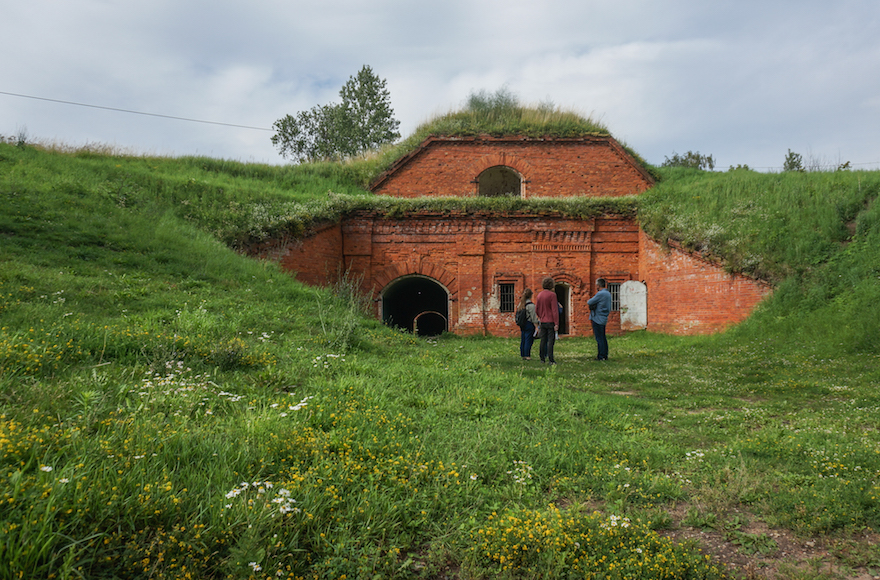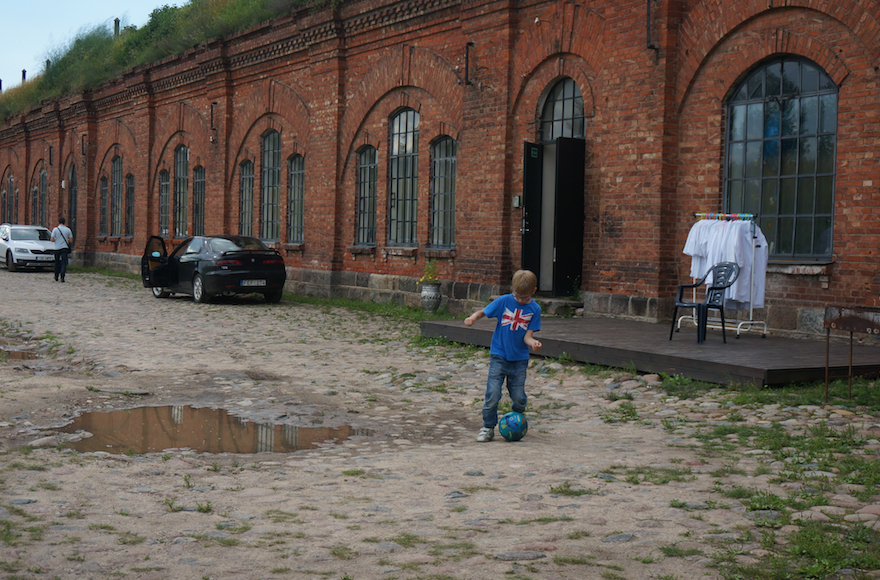
A film crew preparing to record at the former concentration camp known as the Seventh Fort in Kaunas, Lithuania, on July 12, 2016. (JTA/Cnaan Liphshiz)
KAUNAS, Lithuania (JTA) — In this drab city 55 miles west of Vilnius, there are few heritage sites as mysterious and lovely looking as the Seventh Fort.
This 18-acre red-brick bunker complex, which dates to 1882, features massive underground passages that connect its halls and chambers. Above ground, the hilltop fortress is carpeted with lush grass and flowers whose yellow blooms attract bees and songbirds along with families who come here to frolic in the brief Baltic summer.
It’s also a popular venue for graduation parties and wedding receptions, complete with buffets and barbecues, as well as summer camps for children who enjoy the elaborate treasure hunts around the premises.
Most of the visitors are unaware that they are playing, dining and celebrating at a former concentration camp.
In 1941, thousands of Jews were imprisoned, starved and finally massacred by Lithuanian Nazi collaborators at the Seventh Fort in what was then the largest mass killing in the country’s history. The complex is believed to be the first concentration camp located on territory that Nazi Germany conquered following its eastward invasion.
Even by the unfortunate commemorative standards in Eastern Europe — where many Jewish cemeteries and Holocaust sites have been damaged or neglected — the Seventh Fort is unusual for its erasure of the recent past. It was privatized in 2009 and is now owned by the Military Heritage Center — a nongovernmental association run by a 37-year-old Lithuanian informatics [sic] specialist, Vladimir Orlov — which charges admission fees of approximately $4 to some parts of the compound and organizes parties at the venue.
Critics say this reality is a byproduct of the Lithuanian state’s alleged failures in confronting the country’s dark history during the genocide.
“It just says a lot of bad things about my country,” said Ruta Vanagaite, a Lithuanian novelist who drew international attention [sic] to the site in a book she co-authored [sic] last year with Efraim Zuroff, the Israel director [sic] of the Simon Wiesenthal Center. The apparent amnesia surrounding the fort, she added, is also indicative of “the attitude to the people who were killed.”
The remains of 5,000 murdered Jews are buried at the fort in mass graves that are marked by a few poles and rocks. Relatives sometimes light candles in memory of the dead.
The Military Heritage Center’s website tells of the area’s Holocaust-era significance and offers, for a fee, tours of the former killing site alongside a general tour about the fort’s military history. It also has a military history museum but does not have a permanent exhibit about the Holocaust.

A boy playing soccer [sic] at the entrance to the former concentration camp known as the Seventh Fort in Kaunas, Lithuania, on July 12, 2016. (JTA/Cnaan Liphshiz)
The Seventh Fort is one of several controversial issues featured in Vanagaite’s best-selling book “Our People,” which is currently being translated [sic] from Lithuanian to English. A groundbreaking treatise on Lithuanians’ complicity in the Holocaust, the book flies in the face of the government-promoted narrative that speaks of Lithuanians merely as victims of the Russian occupation that replaced the German one.
This sentiment is prevalent across Eastern Europe but is particularly strong in Lithuania, the only country in the world that formally considers Russia’s domination of its territory a genocide. The perception of victimhood, according to Zuroff, for decades has precluded an open debate on the prominent role of thousands of Lithuanian collaborators — some of them honored as patriotic heroes for their anti-communist credentials — in the murder of 95 percent of the country’s Jews.
Jonny Daniels, founder of From the Depths, a Holocaust commemoration group in Poland, said he was “shocked and disgusted” during his visit to the Seventh Fort earlier this month. The site is below “any level of decency and respect,” he said, adding that Lithuania’s government “should hold their heads in shame and be condemned internationally that such an important and holy site be privatized.”
In Poland, Daniels said, “one could be prosecuted for much less.”
The [sic] criticism notwithstanding, Lithuania recently made gestures that drew praise from local and international Jewish groups. Last month, the country’s parliament passed naturalization laws that facilitate the acquisition of Lithuanian nationality for descendants of Litvak Jews. The city of Vilnius, which opened a Yiddish institute in 2001, is planning to build $10 million Jewish museum and is carrying an archaeological excavation [sic] of its former great synagogue.
But Lithuania also has faced harsh criticism for honoring collaborators, including Jonas Noreika, who is believed [sic] to have helped murder Jews, and Juozas Ambrazevicius-Brazaitis, the leader of a local pro-Nazi government. The latter was reburied in Lithuania in a state funeral in 2012, while the former is commemorated with a memorial plaque on a park near the home of Vilnius’ [sic] mayor.
Lithuania has laws against displaying Nazi and communist [sic] symbols, but it is one of a handful EU countries [sic] where one can display a swastika with impunity as per a 2010 court ruling that defines a Baltic variant of the symbol as an ancient part of Lithuanian tradition predating its use by the Nazis. Nonetheless, “classic” swastikas, identical to the ones featured on Nazi Germany’s flag, are sometimes featured in ultranationalist marches that are held annually across Lithuania.
In a country where many again feel threatened by an expansionist Russia, the veneration of such figures as Noreika and Ambrazevicius-Brazaitis “goes hand in hand with cases of disrespect toward the victims” at the Seventh Fort, Zuroff said.
“There’s also an element of concealment — if it’s not commemorated, then it didn’t happen,” he added.
Orlov, the operator of the fort, insisted events are not held on the area where the Holocaust victims are buried, which he said accounts for 2 percent of the entire compound.
“Every place you see in Lithuania has some tragic story. This place is no different,” he told a JTA reporter who inquired about costs for a wedding reception.
Assuring his interlocutor a reception would not be a problem, Orlov promised to send a quote indicating cost. The email was never received — though perhaps it was snared in the interviewer’s spam filter.
Orlov said the financial reports of his organization were “confidential information,” but added it had a growing income of approximately $35,000 annually. All revenues go toward maintenance and educational work on the Seventh Fort, he said, and to paying a staff of 11 an average monthly salary of $11o [sic] — about a third of the minimum wage in Lithuania.
In their [sic] book, Vanagaite and Zuroff revealed that in 2012, Orlov discovered human remains in the area he had purchased. When authorities did not answer his request for resolving issues that arose with his discovery, he had the remains of thousands of Holocaust victims exhumed and placed in trash bags.
“In the pit we discovered a layer of lime, through which what looked like sticks were sticking up. They were the bones of the people shot,” the book quoted Orlov as saying. “After pumping the water out of the ditch and sticking a hand down there, I felt an endless number of bones. Their depth might be several meters.”
He went to the police, the Cultural Heritage Protection Department [sic] and the Jewish community to report his discovery, according to the book. But failing to achieve any result, the book said, Orlov “packed the bones into three garbage bags and left them in a storage space.” Following reports on the situation by the local media, the Kaunas city administration had the bones reburied in 2014 where they had been discovered.
Despite these problems, Lithuanian society is for the first time on the path to dealing with its Holocaust record, Zuroff said.
The book he wrote with Vanagaite [sic] triggered the first major public debate in mass media on the subject, leading to initiatives to revoke state honors for collaborators and a pledge by state historians to “try to publish” this year a list of about 1,000 known Holocaust perpetrators.
Full story here.

